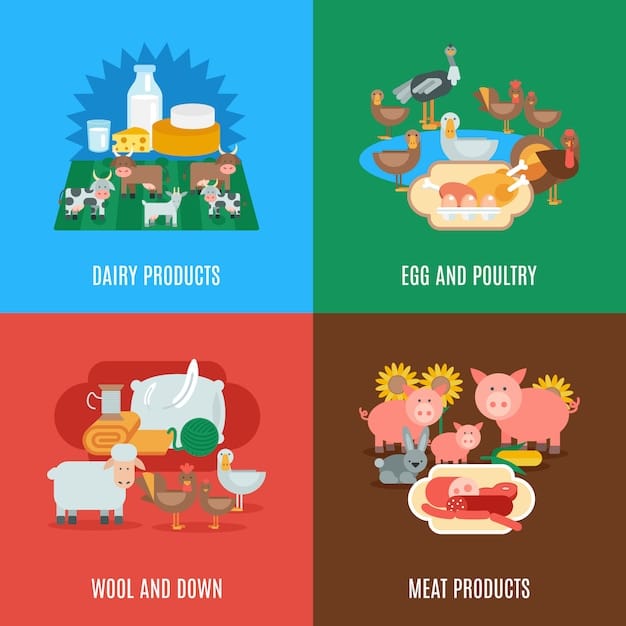The Impact of Food Choices on the Environment: A Data-Driven Analysis

The impact of food choices on the environment is a multifaceted issue involving greenhouse gas emissions, land and water use, and biodiversity implications, necessitating a data-driven analysis for effective sustainable solutions.
Understanding the impact of food choices on the environment: a data-driven analysis is crucial in today’s world, where sustainable living is no longer a choice but a necessity. Every meal we consume has a ripple effect, influencing ecosystems, carbon footprints, and the overall health of our planet.
Understanding the Carbon Footprint of Food
The carbon footprint of food refers to the total greenhouse gas emissions produced by growing, raising, farming, processing, transporting, storing, cooking, and disposing of the food we eat. Different foods have vastly different carbon footprints, with some contributing significantly more to climate change than others.
Data on Meat Consumption
Meat production, particularly beef, is a major contributor to greenhouse gas emissions. The land required for grazing and feed production, combined with methane emissions from livestock, results in a substantial carbon footprint.
Plant-Based Alternatives
Plant-based diets, on the other hand, generally have a much lower carbon footprint. Crops like grains, legumes, and vegetables require less land, water, and energy to produce, making them a more sustainable choice.
- Lower emissions from production and transportation processes.
- Reduced land usage and deforestation.
- Decreased water consumption for irrigation.
- Minimal methane emissions compared to livestock farming.

Reducing meat consumption and embracing plant-based alternatives can significantly lower our individual and collective carbon footprint, contributing to global efforts to mitigate climate change.
The Water Footprint of Our Plates
The water footprint of food is the total volume of fresh water used to produce the goods consumed by the individual or population. Agriculture is one of the largest consumers of fresh water globally, and different foods require varying amounts of water. Understanding this can help us make more sustainable choices.
Foods with High Water Footprints
Some foods, like nuts, rice, and beef, have particularly high water footprints. The irrigation required for these crops, along with the water needed to raise livestock, places a significant strain on water resources. Promoting water efficiency in agriculture is crucial.
Foods with Low Water Footprints
Other foods, such as many fruits and vegetables, have much lower water footprints. By prioritizing these foods, we can reduce our overall water consumption and support more sustainable farming practices. Sustainable irrigation practices can also play a pivotal role.
- Implementing efficient irrigation systems like drip irrigation and micro-sprinklers.
- Utilizing rainwater harvesting techniques for agricultural purposes.
- Promoting the cultivation of drought-resistant crops.
- Adopting soil management practices that enhance water retention.
By choosing foods with lower water footprints and supporting water-efficient farming practices, we can help conserve this precious resource and ensure a more sustainable food system.
Land Use and Deforestation
The amount of land required to produce different foods varies significantly. Some foods require vast expanses of land, often leading to deforestation and habitat loss, while others can be grown more sustainably on smaller plots. Understanding these land use implications is essential for making environmentally responsible food choices.
The Impact of Animal Agriculture
Animal agriculture is a major driver of deforestation, as vast areas of land are cleared to create pasture for grazing and to grow feed crops. This deforestation contributes to habitat loss, biodiversity decline, and increased carbon emissions.
Sustainable Land Management Practices
Choosing foods that require less land can help alleviate pressure on forests and ecosystems. Sustainable land management practices, such as agroforestry and regenerative agriculture, can also help restore degraded lands and enhance biodiversity.
- Promote agroforestry, integrating trees into agricultural systems.
- Implement regenerative agriculture practices that improve soil health.
- Support sustainable forestry to prevent deforestation.
- Adopt land-use planning that balances agriculture and conservation.

By making informed food choices and supporting sustainable land management, we can help protect our planet’s forests and biodiversity for future generations.
Biodiversity Loss and Food Choices
Our food choices can have a profound impact on biodiversity, the variety of life on Earth. Unsustainable agricultural practices, such as monoculture farming and the overuse of pesticides, can harm ecosystems and threaten the survival of countless species.
Monoculture vs. Diverse Ecosystems
Monoculture farming, where a single crop is grown over large areas, reduces biodiversity and makes crops more vulnerable to pests and diseases. Diverse ecosystems, on the other hand, are more resilient and can support a wider range of species.
Promoting Biodiversity Through Food Choices
Choosing foods grown using sustainable and biodiverse farming practices can support healthy ecosystems and protect endangered species. Supporting local and organic farms often aids in promoting biodiversity at a community level.
Intensifying focus on the importance of wildlife corridors and nature reserves is crucial for safeguarding environments, which in turn promotes biodiversity.
Initiate programs that focus on restoring and protecting habitats essential for various species, reinforcing biodiversity.
Cultivating gardens with native plant species helps to attract and support local pollinators and wildlife, fostering local biodiversity.
By making conscious food choices, we can contribute to the preservation of biodiversity and the health of our planet.
Reducing Food Waste
Food waste is a significant environmental problem, contributing to greenhouse gas emissions, resource depletion, and economic losses. Reducing food waste is one of the most effective ways to lessen the environmental impact of our food system. This can be addressed through a variety of approaches.
The Scale of the Problem
A significant portion of the food produced globally is wasted, either during production, processing, distribution, or consumption. This waste ends up in landfills, where it decomposes and releases methane, a potent greenhouse gas.
Strategies for Reducing Waste at Home
Simple changes in our habits, such as meal planning, proper storage, and creative use of leftovers, can significantly reduce food waste. Composting food scraps is also a great way to divert waste from landfills and create nutrient-rich soil.
- Meal planning helps avoid overbuying and ensures that food is used before it spoils.
- Proper storage techniques can extend the shelf life of fruits, vegetables, and other perishables.
- Creative use of leftovers can transform them into delicious and nutritious meals.
- Composting food scraps reduces landfill waste and creates valuable soil amendments.
By addressing food waste at all stages of the food system, we can reduce our environmental footprint and create a more sustainable and equitable food future.
Sustainable Eating: Practical Steps
Adopting a sustainable eating pattern doesn’t have to be complicated. Small changes in our food choices and habits can have a big impact on the environment. Sustainable eating promotes the creation of healthier ecosystems and a decrease in pollution in our environments.
Prioritize Plant-Based Foods
Increasing our consumption of plant-based foods, such as fruits, vegetables, grains, and legumes, is one of the most effective ways to reduce our environmental impact. These foods generally have a lower carbon footprint, water footprint, and land use impact compared to animal products. This encourages environmentally responsible patterns.
Buy Local and Seasonal
Purchasing food from local farmers and choosing seasonal produce reduces transportation emissions and supports local economies. It also ensures that we are eating foods that are in season, which tend to be more flavorful and nutritious. Support local farms and markets.
Buying locally can encourage community growth by keeping money within local communities and small businesses. Buying seasonally can assist in decreasing transportation emissions, promoting a lesser carbon footprint. Additionally, local farmers typically use more sustainable farming practices.
Ensuring minimal packaging waste by bringing reusable bags and containers to markets contributes to less waste pollution.
By taking these practical steps, we can create a more sustainable and resilient food system that benefits both people and the planet.
| Key Point | Brief Description |
|---|---|
| 🌱 Plant-Based Diets | Lower carbon footprint and reduced resource use. |
| 💧 Water Consumption | Choosing low water footprint foods. |
| 🌳 Deforestation | Reducing animal agriculture to preserve forests. |
| 🗑️ Food Waste | Reducing waste to lower emissions and resource depletion. |
FAQ
▼
Meat consumption significantly contributes to greenhouse gas emissions, land use for pasture and feed production, and water consumption, especially beef.
▼
Reducing food waste decreases methane emissions from landfills, conserves resources used in production, and lowers the carbon footprint of the food system.
▼
Sustainable alternatives include agroforestry, regenerative agriculture, and crop diversification, which enhance soil health, conserve water, and promote biodiversity.
▼
Buying local food reduces transportation emissions, supports local economies, and often involves more sustainable farming practices compared to large-scale agriculture.
▼
You can reduce your water footprint by choosing foods with low water requirements, such as many fruits and vegetables, and avoiding high-water-consuming foods like beef and nuts.
Conclusion
In conclusion, the impact of food choices on the environment: a data-driven analysis reveals that our dietary decisions have far-reaching consequences. By making informed choices, reducing waste, and supporting sustainable practices, we can collectively contribute to a healthier and more sustainable planet.





